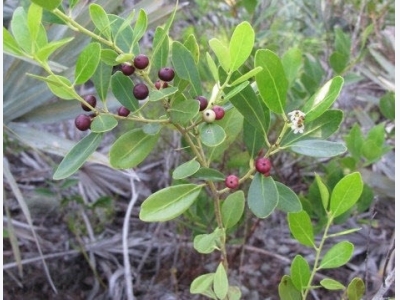How to Grow Inkberry (Evergreen Winterberry)

Native to the eastern United States, the inkberry shrub (Ilex glabra) might just be the answer to a problem area in your yard. This evergreen shrub tolerates and even thrives in continually wet soils where other plants fail.
It’s also more disease-resistant and cold-hardy than most holly species and suffers less winter burn than boxwood.
Keep in mind that this isn’t the right shrub if you live in a dry climate, and it prefers slightly acidic soil over alkaline soil. It’s not the best choice in the Rocky Mountain area, where it may develop iron chlorosis due to the alkaline soil or suffer from continuously dry conditions. But if you live in the East or the Pacific Northwest, inkberry will likely thrive in your yard.
Planting Inkberry
Hardy in U.S. Department of Agriculture plant hardiness zones 4 to 9, inkberry is widely available in various sizes at nurseries and home centers. It grows best in full sun, although it tolerates partial shade. In its native setting, it is often found as an understory plant in woodlands and forests. Plant potted plants or balled and burlapped shrubs in early spring. Dig a hole as deep and twice as wide as the root ball. Add peat moss to acidify slightly alkaline soils and hold moisture. Remove the plant gently from its pot and set it in the hole. Fill the hole half-full with soil. Add 2 gallons of water and allow the water to drain. Fill the hole with the remaining soil and tamp the soil down with your foot.
Water inkberry shrubs at least once per week or more in dry weather, especially during the first few weeks after planting. The soil must stay consistently moist while the shrubs become established. Fertilize inkberry shrubs in spring with an acidic fertilizer for azaleas according to package directions.
Inkberry can be sheared as you would privet or boxwood to make a formal hedge, but it’s best left as an informal hedge. Prune it in spring just to remove dead branches or branches that rub against each other. Inkberry spreads through suckering and can quickly form colonies. Remove the suckers to prevent the shrubs from spreading out of bounds.
Inkberry shrubs produce small white flowers in the spring, followed by dark blue or purple berries that persist through winter. The plants are dioecious, meaning that you must have a male plant to pollinate a female plant. If you want the shrubs to produce berries, be sure to plant both male and female plants.
Inkberry Pests and Diseases
One of the best things about inkberry is its resistance to disease and insect pests. With the exception of a few cosmetic leaf spot issues, this shrub rarely suffers from insect and disease problems. Be sure to keep it watered and plant it in acidic soil and you’ll find it’s a long-lived, low-maintenance shrub.
As the shrubs age, the foliage at the base of the plants becomes thin. Plant smaller shrubs or perennials in front of inkberry to hide this shortcoming or choose a variety such as ‘Nora’ that remains fuller.
Inkberry Varieties
Always select a cultivar, rather than a species plant. Cultivars are more compact, less leggy and less likely to spread. In general, they’re just better behaved plants. Below are a few to consider:
‘Compacta’ is a female plant that grows to 5 feet.
‘Nordic’ is a male variety that remains at 4 feet or less. Very dense, compact form and hardy to USDA plant hardiness zone 3.
‘Shamrock’ stays very compact at just 2 feet and has glossy leaves and a pleasing form.
Related news
 How to Grow Melampodium (Butter Daisy)
How to Grow Melampodium (Butter Daisy) Melampodium is a bright and carefree annual flower that is not used nearly enough.
 How to Grow Coconut Palm
How to Grow Coconut Palm Few trees are more exotic than the coconut palm (Cocos nucifera Linn.). This regal tree produces edible seeds – coconuts. Unfortunately, coconut palms are hardy
 How to Grow Weeping Willow Trees
How to Grow Weeping Willow Trees In a wide, sweeping lawn or near a pond or lake, weeping willows make a calming and picturesque addition to the landscape. Unfortunately, they have several